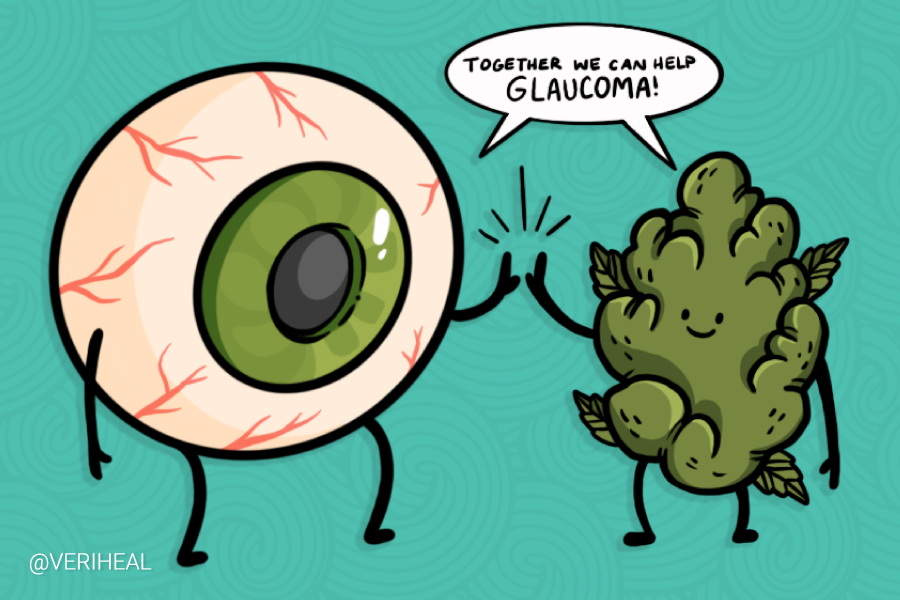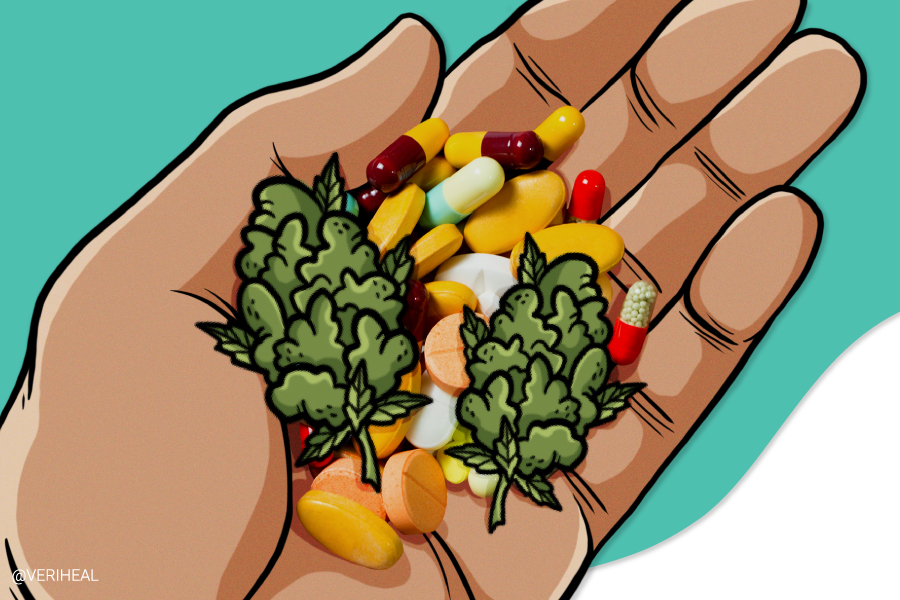Marijuana and Macular Degeneration: How CBD Could Help Combat Age-Related Macular Degeneration (AMD)

- What is AMD
- How Cannabis Can Help Relieve the Symptoms of Age-Related Macular Degeneration (AMD)
- Medical Cannabis and Inflammation
- Medical Cannabis as a Neuroprotectant: A Patient’s Perspective
- Research on AMD and Medical Marijuana
- Types Of Age-Related Macular Degeneration
- Risk Factors of Age-Related Macular Degeneration
- Lowering Your Risk for AMD
What is AMD?
There is no known cure for Age-related Macular Degeneration (AMD), a condition caused when a tiny part of the retina called the macula deteriorates. Rarely, AMD could lead to permanent vision loss for individuals past the age of 60.
Currently, the National Eye Institute reports that 11 million Americans suffer from this age-related condition caused by the weakening of the macula, although it is likely under reported (10). Made up of photoreceptor cells, the macula detects light and images and signals the brain to interpret what is in the central vision (11). Though there are many types of macular disease, AMD is the most common. When AMD sets in, the macula weakens, causing visual impairments including sharp details becoming blurry, difficulty reading, recognizing faces, and differentiating colors.
Unlike other macular diseases, AMD is directly related to aging, primarily affecting the elderly. Bright Focus reports the global cost of the condition is $343 billion, with up to $98 million in collective healthcare costs for the U.S, Canada, and Cuba (1). According to Johns Hopkins University, age-related macular degeneration is the leading cause of vision loss in people 50 and older, and although it can cause a severe loss of central vision it rarely causes people to go blind (5).
How Cannabis Can Help Relieve the Symptoms of Age-Related Macular Degeneration (AMD)
As an anti-inflammatory agent, THC could reportedly assist in temporarily lowering intraocular pressure and free radicals that lead to vision loss specifically for those living with glaucoma. A study published in Pharmacology & Therapeutics suggests that THC helps lower intraocular pressure, potentially preventing vision loss (6). Meanwhile CBD has a THC-countering effect in the eyes that could block its lowering of IOP (intraocular pressure) (8). Some patients with glaucoma who smoked medical cannabis reported clearer vision. These effects are generally short-term and are not yet confirmed by large studies.
However, United Patients Group reports CBD benefits that may assist with clearer vision (2). For example, it stunts the vascular endothelial growth factor (VEGF). A cancer research study on mice suggested that CBD, “lowered the expression of various VEGF pathway-related genes.” Along with the ability to inhibit VEGF, cannabinoids may theoretically alleviate macular disease symptoms since they inhibit angiogenesis, are neuro-protective and reduce ocular pressure (3). Such effects require direct eye research to confirm, as they can only be extrapolated at this time.
Medical Cannabis and Inflammation
Medical cannabis is a powerful anti-inflammatory drug. Cannabinoids play an important role in the regulation of the immune system through activating cannabinoid receptors in the Endocannabinoid system (ECS).
When your body activates your immune system, it sends out inflammatory cells and signals. These cells attack bacteria and often damage healthy tissue as well. Inflammation is a feature of some degenerative eye diseases such as glaucoma and AMD.
Inflammation is one of the most common conditions targeted with medical cannabis. As stated above, cannabinoids are known anti-inflammatory and antioxidant agents (9). Cannabidiol may be an effective treatment for inflammation in glaucoma patients and individuals with AMD although further research in this area in order to make a recommendation.
Medical Cannabis as a Neuroprotectant: A Patient’s Perspective
A patient in Taos, New Mexico who suffered from AMD found amazing results with CBD after taking it sublingually under her tongue at the suggestion of an herbalist, according to the United Patients Group. However, before finding CBD, the patient had several injection treatments to inhibit VEGF, which are painful and invasive. While the United Patients group reports, “no studies have been done on cannabinoid therapy and AMD directly,” there may be a correlation between taking CBD and improvement in symptoms according to patient reports like this one (2).
Until further research takes place, the use of medical cannabis in the treatment of AMD will continue to be studied along with many other conditions for which patients are successfully using cannabinoids.
Research on AMD and Medical Marijuana
To date, there is no direct evidence that cannabis can help with AMD. Cannabis smoke creates tar that contains some of the similar carcinogens of tobacco smoke, and so any kind of smoking should be avoided to prevent the development of AMD since smoking increases your chances of developing it later in life. It may be possible that forms of cannabis ingestion other than smoking could be beneficial for other aspects of treating symptoms that present with AMD but at this time there is currently no research to support using cannabis for AMD.
Types of Age-Related Macular Degeneration
Understanding the different kinds of AMD is important to have a grasp of the disease on the whole. There are two forms of AMD: dry and wet. Let’s explore the two types of AMD and how they are characterized.
Wet AMD
Wet age-related macular degeneration is also called advanced neovascular AMD. It is a less common type of late AMD that usually causes faster vision loss. It’s important to note that any stage of dry AMD can turn into wet AMD—but wet AMD is always a late stage.
It occurs when abnormal, leaky blood vessels grow in the back of the eye and damage the macula. As mentioned before it is the less common type of AMD and only accounts for about 10 percent of cases. Wet AMD accounts for roughly 10% of AMD cases, but 90% of the time leads to legal blindness (1).
Unlike dry AMD, wet AMD can be treated effectively with medication. Treatments can also include visual therapy and vision aids. With regard to pharmaceutical treatments, “Wet AMD is usually treated using the following medications, which belong to a group of drugs known as anti-vascular endothelial growth factor (anti-VEGF) drugs Ranibizumab (trade name: Lucentis) and Aflibercept (Eylea) (4).”
Side effects of these treatments may include temporary eye pain, raised pressure inside of the eye, and seeing spots or dots that follow the eye’s movements.
Additionally, it should be noted that serious side effects of this treatment are “inflammation of the inside of the eye (endophthalmitis) or the middle layer of the eye (uveitis), cataracts or retinal damage. In total, these types of side effects occur in less than 1 out of 100 people (4).”
Dry AMD
Most people with AMD have dry AMD, which is also referred to as atrophic AMD. This is when the macula gets thinner with age. The symptoms of dry AMD depend on the stage. Dry AMD happens in 3 stages: early, intermediate, and late.
It usually progresses slowly over several years, and symptoms tend to worsen over time. While early-stage dry AMD and some cases of intermediate dry AMD typically do not cause symptoms, some patients with intermediate dry AMD and patients with late AMD will often notice symptoms including blurriness and trouble seeing in low lighting. Over time these symptoms progress to colors appearing less bright and the blurry area expanding. Straight lines appearing wavy is a warning sign for late AMD, and patients should seek care from their eye doctor immediately.
Annual dilated eye exams can help catch the early stages of AMD and other optical diseases, which adds to the importance of routine eye exams. Individuals with preexisting conditions like diabetes, hypertension, and hyperlipidemia may need more regular eye exams. Persons with known family history of AMD or vision problems should consult their doctor and optometrist for evaluation and follow up.
There is currently no treatment for late dry AMD, but if unfortunately caught in a late stage you can find ways to make the most of your remaining vision and relieve symptoms. Prevention and early detection are always best practices.
Risk Factors of Age-Related Macular Degeneration
According to Mayo Clinic, risk factors of AMD include:
- Age – People over 60 are at higher risk
- Family history and genetics – Several genes are linked to this disorder that can be inherited
- Race – Caucasian people have more odds of developing AMD
- Smoking – First and second-hand smoke increases odds of developing AMD
- Obesity – May accelerate the development of intermediate stage AMD to more severe late stage
- Cardiovascular disease – Conditions that affect the heart and blood vessels like diabetes and high blood pressure may increase the risk of AMD (7).
Lowering Your Risk for AMD
Research shows that you may be able to lower your risk of AMD (or slow vision loss from AMD) by making these healthy choices:
- Avoid smoking
- Regular physical activity
- Maintain healthy blood pressure and cholesterol levels
- Eat healthy foods, including foods high in nutrients such as leafy green vegetables and fish (10)
Note: The content on this page is for informational purposes only and is not intended to be professional medical advice. Do not attempt to self-diagnose or prescribe treatment based on the information provided. Always consult a physician before making any decision on the treatment of a medical condition.
1. Age-related macular degeneration: Facts & figures. Age-Related Macular Degeneration: Facts & Figures | BrightFocus Foundation. (n.d.). Retrieved April 26, 2022, from https://www.brightfocus.org/macular/article/age-related-macular-facts-figures
2. Author, J. M. A. the. (2021, April 13). Cannabis and macular degeneration helping patients. United Patients Group. Retrieved April 26, 2022, from https://unitedpatientsgroup.com/blog/cannabis-macular-degeneration/
3. Blázquez, C., González-Feria, L., Álvarez, L., Haro, A., Casanova, M. L., & Guzmán, M. (2004). Cannabinoids inhibit the vascular endothelial growth factor pathway in gliomas. Cancer Research, 64(16), 5617–5623. https://aacrjournals.org/cancerres/article/64/16/5617/511589/Cannabinoids-Inhibit-the-Vascular-Endothelial
4. IQWiG (Institute for Quality and Efficiency in Health Care). (2008). Age-related macular degeneration (AMD): What medications … Age-related macular degeneration (AMD): What medications are used to treat wet AMD? Retrieved April 26, 2022, from https://www.ncbi.nlm.nih.gov/books/NBK315795/
5. Johns Hopkins Medicine. (n.d.). Age-related macular degeneration (AMD). Johns Hopkins Medicine. Retrieved April 26, 2022, from https://www.hopkinsmedicine.org/health/conditions-and-diseases/agerelated-macular-degeneration-amd#:~:text=Age-related%20ma
6. Järvinen, T., Pate, D. W., & Laine, K. (2002). Cannabinoids in the treatment of glaucoma. Pharmacology & Therapeutics, 95(2), 203–220. https://www.sciencedirect.com/science/article/abs/pii/S0163725802002590
7. Mayo Clinic Staff. (2021, May 8). Dry macular degeneration. Mayo Clinic. Retrieved April 26, 2022, from https://www.mayoclinic.org/diseases-conditions/dry-macular-degeneration/symptoms-causes/syc-20350375
8. Miller, S., Daily, L., Leishman, E., Bradshaw, H., & Straiker, A. (2018). Δ9-tetrahydrocannabinol and cannabidiol differentially regulate intraocular pressure. Investigative Opthalmology & Visual Science, 59(15), 5904. https://pubmed.ncbi.nlm.nih.gov/30550613/
9. Nagarkatti, P., Pandey, R., Rieder, S. A., Hegde, V. L., & Nagarkatti, M. (2009). Cannabinoids as novel anti-inflammatory drugs. Future Medicinal Chemistry, 1(7), 1333–1349.https://www.ncbi.nlm.nih.gov/pmc/articles/PMC2828614/
10. U.S. Department of Health and Human Services. (n.d.). Age-related macular degeneration. National Eye Institute. Retrieved April 26, 2022, from https://www.nei.nih.gov/learn-about-eye-health/eye-conditions-and-diseases/age-related-macular-degeneration
11. What is macular degeneration? – AMDF. American Macular Degeneration Foundation. (2017, December 20). Retrieved April 26, 2022, from https://www.macular.org/what-macular-degeneration








